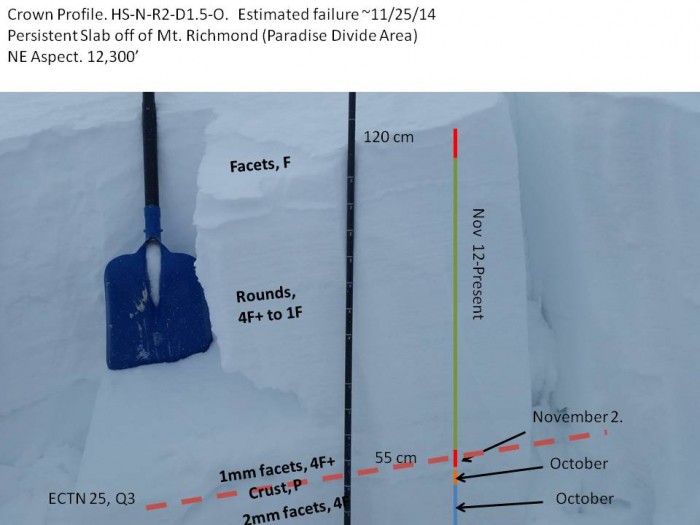Name: Zach Guy
Location: Paradise Divide Area
Date of Observation: 11/30/2014
Aspect: North, North East
Elevation: 9,500 ft – 12,400 ft
Avalanches: No recent slides. The crown investigated was a NE aspect at 12,300 ft on Mt. Richmond. HS-N-R2-D1.5-O that likely failed about 5-6 days ago. The slab was 50-100 cm deep, 1F hardness. It failed on a thin layer of ~1mm rounding facets (Nov 12 interface) over a 2 cm meltfreeze crust (late October layer), which caps a thicker layer of 2-2.5 mm faceted crystals (October layers). Stability test above the crown was ECTN 25 Q3 on the Nov 12 facet layer
Weather: High, thin overcast, warm temps, and moderate NW winds
Snowpack: Below treeline: Snowpack is entirely faceted; no concerning structures. Still supportive on skis but trending towards trap-door. Surface is fist-hard near surface facets.
Near and Above treeline: Snowpack is quite variable. Most areas (~70% of terrain) hold a shallow snowpack (<80 cm) due to wind erosion. The snowpack there is faceting from the top down, with easy pole plants to the ground and lacking a concerning structure. Specific windloaded features, such as gullies and below convexities, are still harboring slabs up to 130cm thick and 1F in hardness. Several targeted stability tests in these suspect areas showed poor propagation potential on the basal weak layers (ECTN, ECTX on October and early November facets, 4F to 4F+, .5 mm up to2.5 mm in size). One of these pits was dug at the crown of a persistent slab avalanche that failed an estimated 5-6 days ago. The Nov 22 interface was consistently indistinct and produced no results in stability tests. We jumped around on numerous small test slopes and traveled on steep terrain with no signs of instability. The surface is mostly soft, wind-rippled near surface facets with pockets of firm windboard.
I quickly poked onto a steep South aspect at 12,300 feet. The surface is a supportive melt-freeze crust roughly 2″ thick.

Crown profile from older slide on Mt. Richmond. NE Aspect ATL




